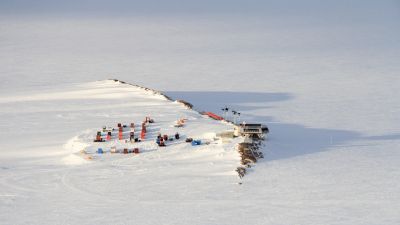
Hampered by bad weather, Antarctic Season Begins at Zero Emission Research Station
Antarctica, 12 November 2012 – An International Polar Foundation [1] operations team led by expedition leader Alain Hubert arrived today at Princess Elisabeth Antarctica - the world’s first zero emission polar station. Delayed almost one week due to heavy snow at Russia’s Novo Air Base, the team’s arrival marks the end of winter, and the start of an intensive four-month scientific research season.
The station’s team travelled from Cape Town on board an Ilyushin Il-76 aircraft, via Novo, reaching Princess Elisabeth Antarctica this morning at 10:24am CET [2] [3].
“With the first research teams arriving in only one week, and with important innovations planned for the continuing evolution of Princess Elisabeth Antarctica, we’re not going to let this small delay worry us”, said expedition leader Alain Hubert. “Princess Elisabeth Antarctica is up and running, and as soon as we have checked the state of all installations, we will be ready to welcome the many researchers who are due to come here this season. We’re proud to be supporting the work of top polar scientists who travel here to carry out important research helping us to understand the nature of the Earth and climate related mechanisms.”
During the 2012-2013 BELARE season, the station will host some 30 scientists working in the fields of atmospheric science, glaciology, meteorology, geology, and microbiology, from several different countries, including large campaigns from Belgium, Germany and Japan [4].
German glaciologist Reinhard Drews will travel to Princess Elisabeth Antarctica later in November. Drews was awarded the InBev Baillet Latour Antarctic Fellowship in October, for his work in investigating how the potential disintegration of Antarctic floating ice shelves could contribute to increased ice flow from inland glaciers, and a resulting rise in global sea levels [5].
Amongst ongoing construction projects at the station is a remodelling of the station’s water treatment system, which will see it become one of the most advanced in Antarctica. The station’s membrane bioreactor is a unique prototype installation, based on space technology, which can provide a recycled water supply for 20-30 people.
"Princess Elisabeth Antarctica continues to lead the way in demonstrating that ideas that we put in place here in the tough Antarctic environment can influence how we manage energy use and water treatment in our homes, workplaces and cities, and lay the groundwork for a new era of sustainable development", said Hubert.
The International Polar Foundation supports polar scientific research for the advancement of knowledge, the promotion of informed action on climate change, and the development of a sustainable society.
ENDS
Contacts:
International Polar Foundation
+32 2 543 06 98
press@polarfoundation.org
Twitter: @polarfoundation and @antarcticbase
Notes:
For more about Princess Elisabeth Antarctica, visit www.antarcticstation.org
For more about the International Polar Foundation, visit www.polarfoundation.org
[1] The International Polar Foundation is the appointed operator of Princess Elisabeth Antarctica station for the Belgian State.
http://www.antarcticstation.org/management/secretariat/
[2] The Ilyushin Il-76 flight BT-67 (Lidia C-GEAI) departed Cape Town at 2129 UTC (1029 CET) on 11 November, and arrived at Novo 0315 UCT (0414 CET) on 12 November 2012. The connecting flight to Princess Elisabeth Antarctica landed at 0924 UTC (1024 CET).
[3] Princess Elisabeth Station is located in the Sør Rondane Mountain Range, Dronning Maud Land, East Antarctica. The station lies at 71° 57' S and 23° 20' E, 220 km due South from the edge of the ice shelf.
[4] Details on all science projects at Princess Elisabeth in 2012-2013
http://www.antarcticstation.org/science_projects/category/2012_2013/
Research Projects include:
- BELATMOS - Ozone, UV radiation and aerosols - Belgian Royal Meteorological Institute (RMI), Dr. Alexander Mangold
- ICECON: Understanding ice dynamics – led by the Université Libre de Bruxelles (ULB)
- BELDIVA: Exploration of microbiology diversity – Satoshi Imura, National Institute of Polar Research (NIPR), Japan
- GIANT-LISSA: Dr Olivier Francis, University of Luxembourg will install an absolute gravimeter
- GEAII: Polar 6 airborne survey, Alfred Wegener Institute (Germany)
- SAMBA: Meteorite search on the Nansen Icefields, Vrije Universiteit Brussel (VUB), ULB, and NIPR.
- LGGE: Surface mass balance observations on behalf of Grenoble-based Laboratoire de Glaciologie et Géophysique de l'Environnement (LGGE), France
- Micrometa: Search for microscopic extraterrestrial dust (VUB)
- BE:WISE: Research on buttressing effects on ice shelves (ULB)
[5] Antarctic Ice Sheet Scientist Awarded €150,000 Fellowship
About Princess Elisabeth Antarctica:
As an Antarctic legacy project of the 2007-2009 International Polar Year, Princess Elisabeth Antarctica research station was designed and built to respect the letter and spirit of the Madrid Protocol to the Antarctic Treaty. But the project went a step further: Princess Elisabeth is the world’s first Zero Emission polar research station. Located in East Antarctica’s Sør Rondane Mountains, Princess Elisabeth Antarctica welcomes scientists from around the world to conduct research in this little-studied and pristine environment.
Operated by the International Polar Foundation, in partnership with the Belgian Polar Secretariat, the station is an evolving technical prototype. Princess Elisabeth Antarctica’s design and construction seamlessly integrate passive building technologies, renewable wind and solar energy, water treatment facilities, continuously monitored power demand and a smart grid for maximising energy efficiency.
The success of Princess Elisabeth Antarctica marks an important development in the philosophy of sustainable development, demonstrating how the climate challenge can be met through goodwill and collaboration between civil society, business and governments. The project proves how readily accessible technology can be harnessed to achieve a low carbon society, without compromising our collective or individual wellbeing.
The energy solutions perfected at Princess Elisabeth Antarctica are already being successfully commercialised by the project’s technical partners for use in mainstream applications.
